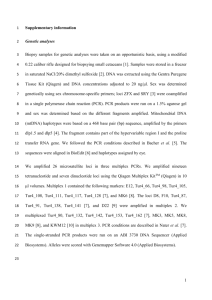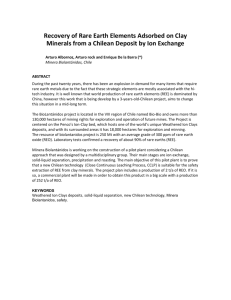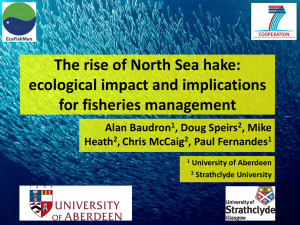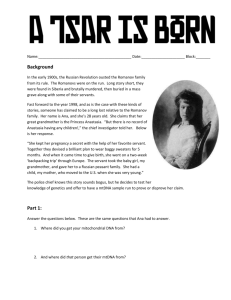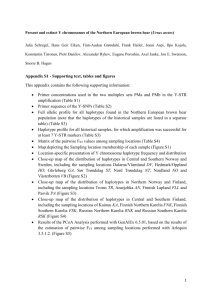Título : Mitochondrial DNA
advertisement
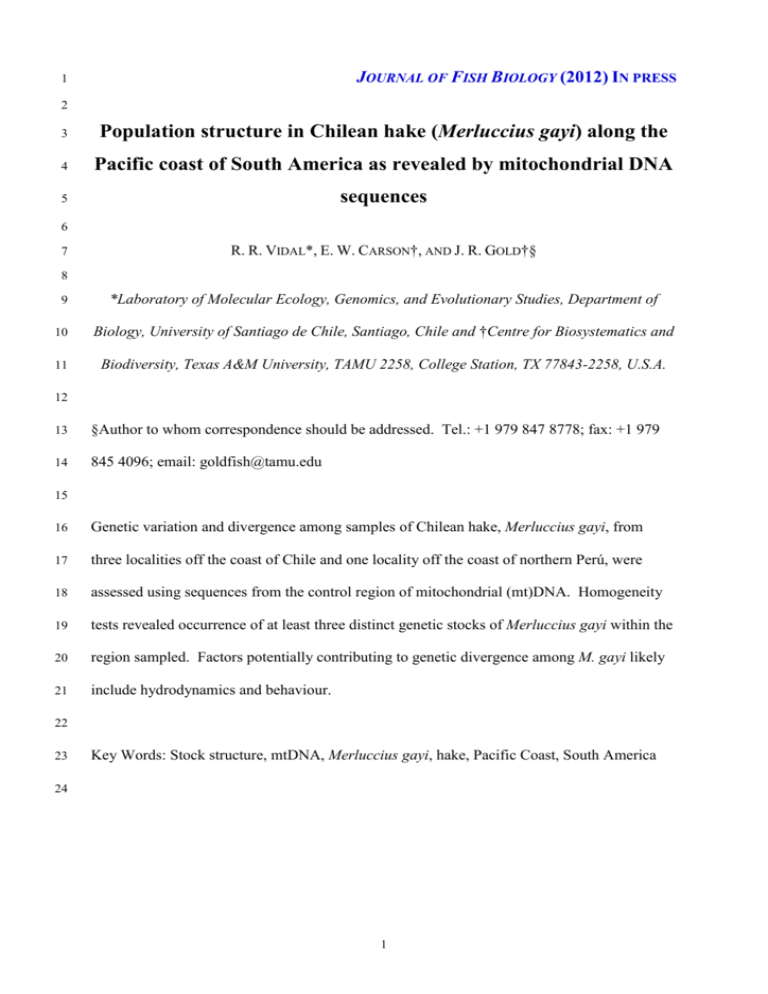
JOURNAL OF FISH BIOLOGY (2012) IN PRESS 1 2 3 Population structure in Chilean hake (Merluccius gayi) along the 4 Pacific coast of South America as revealed by mitochondrial DNA 5 sequences 6 7 R. R. VIDAL*, E. W. CARSON†, AND J. R. GOLD†§ 8 9 *Laboratory of Molecular Ecology, Genomics, and Evolutionary Studies, Department of 10 Biology, University of Santiago de Chile, Santiago, Chile and †Centre for Biosystematics and 11 Biodiversity, Texas A&M University, TAMU 2258, College Station, TX 77843-2258, U.S.A. 12 13 §Author to whom correspondence should be addressed. Tel.: +1 979 847 8778; fax: +1 979 14 845 4096; email: goldfish@tamu.edu 15 16 Genetic variation and divergence among samples of Chilean hake, Merluccius gayi, from 17 three localities off the coast of Chile and one locality off the coast of northern Perú, were 18 assessed using sequences from the control region of mitochondrial (mt)DNA. Homogeneity 19 tests revealed occurrence of at least three distinct genetic stocks of Merluccius gayi within the 20 region sampled. Factors potentially contributing to genetic divergence among M. gayi likely 21 include hydrodynamics and behaviour. 22 23 Key Words: Stock structure, mtDNA, Merluccius gayi, hake, Pacific Coast, South America 24 1 25 The Chilean hake (Merluccius gayi Guichenot) is a demersal marine fish found in cold, 26 poorly oxygenated, coastal upwelling ecosystems along the Pacific coast of South America 27 from southern Chile to northern Perú. The species is mainly concentrated between 100-200 m 28 depth (Guevara-Carrasco & Lleonart, 2008) and supports an extremely important bottom- 29 trawl fishery in both countries, especially in Chile where there are both domestic and export 30 markets. Annual landings of M. gayi in Chile historically exceeded 100,000 tons (Giddings, 31 1980). Since 2000, however, there have been declines in length-at-catch, proportion of 32 mature females, catch per unit effort, and adult biomass and size (Arancibia & Neira, 2008). 33 The species is fully exploited in Chile (Payá & Ehrhardt, 2005), but remains an important 34 low-cost, fresh-market commodity throughout most of the country. 35 The M. gayi resource is managed in Chilean waters as a single stock (Aguayo-Hernández, 36 1995), consistent with a study by Galleguillos et al. (2000) who found no differences in allele 37 frequencies at six allozyme loci among geographic samples spread across a distance of ~1,335 38 km. Galleguillos et al. (2000) did report heterozygote deficiencies at Idh-1 between samples 39 from one locality and at Aat-1 between samples from another locality, suggesting possibly a 40 mixture of different subpopulations (Wahlund 1928). George-Nascimento (1996) and Oliva 41 & Ballón (2002) suggested there were two ‘ecological’ stocks of M. gayi along the Chilean 42 coast, based on consistent geographic differences in abundance of metazoan parasite 43 assemblages. A tag-and-release experiment of M. gayi in Chilean waters (Villegas & 44 Saetersdal 1968) indicated that adult M. gayi can move considerable distances. 45 In this study, we analysed sequences of mitochondrial (mt)DNA acquired in an earlier, 46 unpublished study, undertaken in 1998-1999, involving four geographic samples of M. gayi 47 (three from Chile) taken along the central coast of South America. Because mtDNA can be 48 more sensitive to demographic disruptions than nuclear-encoded genes (Birky et al. 1983), we 49 sought to (re)examine the current stock-structure model for M. gayi in Chilean waters and test 50 the null hypothesis that M. gayi along the Chilean coast are a single genetic stock. Our 2 51 reasons were twofold: (i) population structure is a central issue for management of fishery 52 resources (Begg et al., 1999; Hilborn et al., 2003), especially if a species is fully exploited and 53 there is a possibility of overfishing a non-identified stock (Ruzzante et al., 1999); and (ii) 54 there are simply too few resources available at present to undertake a more comprehensive 55 study. 56 The fourth sample of M. gayi was from Peruvian waters. We included it in part because 57 M. gayi in Peruvian waters is considered a different subspecies: M. g. peruanus (Peruvian 58 waters) and M. g. gayi (Chilean waters). The two subspecies differ in morphology (Ginsburg 59 1954; Inada 1981) and allozyme alleles at three monomorphic loci (Hernández et al., 2000), 60 and are separated physically by a narrow continental shelf and concentrations of hydrogen 61 sulphide in bottom layers in the region between their non-overlapping ranges (Inada, 1981). 62 The two subspecies are managed essentially as two distinct stocks (Aguayo-Hernández, 1995; 63 Espino et al., 1995) 64 Muscle tissues from fish sampled at four offshore localities (Fig. 1) were obtained from 65 the commercial fishery. Latitude/longitude for each sample are as follows: Perú (7oS, 79oW); 66 Coquimbo (29oS, 71oW); Valparaíso (33oS, 71oW); and Corral (39oS, 73oW). Tissues were 67 fixed in non-denatured ethanol and stored at room temperature. Samples from Chile were 68 obtained during the Austral spring, while the sample from Perú was obtained during the 69 Austral winter. Extraction and storage of mtDNA followed Quintero et al. (2000). 70 Polymerase-chain-reaction (PCR) primers L15998 (Alvarado-Bremer, 1994) and heavy-strand 71 primer B (Lee et al., 1995) were used to amplify a 395 base-pair (bp) fragment of the 72 mitochondrial control region. Details of amplification conditions may be obtained from RVV. 73 Amplified mtDNA fragments were sequenced using an ABI PRISM 377. Sequences were 74 compiled and checked for accuracy. Clustal W (Thompson et al., 1994) was used for multiple 75 sequence alignments; mtDNA sequences were deposited in GenBank. 3 76 Summary statistics were computed using DNASP, v5.10.01 (Rozas et al., 2003). 77 Homogeneity in haplotype number and haplotype diversity was tested using a bootstrap re- 78 sampling approach. POP TOOLS (http://www.poptools.org) was used to generate random 79 samples of 20 haplotypes from the overall dataset of 80 individuals; the expected average 80 number of haplotypes, average haplotype diversity, and their upper (0.975) and lower (0.025) 81 percentiles were recorded based on random sampling (1,000 iterations) under Monte Carlo 82 simulation. Observed values were considered to differ significantly from expected values 83 under the null hypothesis if they fell outside the obtained confidence intervals. Selective 84 neutrality of mtDNA was tested via Fu’s (1997) FS statistic and Fu & Li’s (1993) D* and F* 85 statistics, with significance of FS, D*, and F* assessed from 10,000 coalescent simulations 86 (Rozas et al., 2003). A minimum spanning network of mtDNA haplotypes was constructed in 87 Fluxus Network v4.6 (fluxus-engineering.com), using the full median-joining algorithm 88 (Bandelt et al., 1999). Epsilon and character weights for the median joining algorithm were 89 set to the default value (= 0), with the exception of character weights at indel sites, which 90 were double weighted (= 20), as recommended in the user manual; additional testing of higher 91 and lower weights did not change network structure. 92 Homogeneity of mtDNA haplotype distribution was tested via exact tests and analysis of 93 molecular variance (AMOVA) as implemented in ARLEQUIN (Excoffier & Lischer 2010). 94 Pairwise estimates of ΦST, generated using ARLEQUIN, were tested for homogeneity, using 95 exact tests. Isolation by distance was assessed via spatial autocorrelation analysis (Smouse & 96 Peakall, 1999) as implemented in GenAlEx v. 6.0 (Peakall & Smouse, 2006). Geographic 97 distance between individual localities was determined from longitude and latitude. Multiple 98 distance-class sizes (0 – 500 km, 0 – 1,000 km, and 0 – 3,000 km) were determined based on 99 the distribution of geographic distances between localities. Significance of spatial 100 autocorrelation (r) was determined via random permutations of genotypes of individuals 101 sampled in each locality, following (Saillant et al., 2010). Significance of r also was tested by 4 102 generating 95% confidence intervals for r, using 1,000 bootstrap values obtained by sampling 103 pairs of localities within a given distance class. Significance of r was inferred when the 95% 104 CI did not overlap zero. 105 A total of 20 mtDNA haplotypes was detected among the four localities (Appendix 1). 106 Variable positions within the 395 bp fragment included 23 base substitutions (18 transitions, 107 five transversions) and three one-base deletions. Haplotypes that contained one-base 108 deletions are designated with a subscript. Haplotypes B1 and B2 contained deletions at 109 nucleotide sites 79 and 150, respectively, but were otherwise identical to Haplotype B; 110 Haplotype H1 contained a deletion at nucleotide site 3 and remained unique even if the 111 deletion was not considered. 112 Summary statistics for the four localities are presented in Table I. Bootstrap resampling 113 indicated that the observed number of haplotypes in the samples from Perú, Coquimbo, and 114 Valparaíso deviated significantly from the lower (0.025) percentile of 8, generated from 115 random subsamples of the overall data set; observed haplotype diversity in the sample from 116 Valparaíso was marginally (but significantly) less than the lower (0.025) percentile of 0.832. 117 Tests of selective neutrality were non-significant for all four localities (data not shown but 118 available from EWC). The minimum spanning network of mtDNA haplotypes (Fig. 2) 119 consisted of two Steiner trees that were identical in topology except for the relationship of 120 Haplotype L to Haplotype C where two alternative connections each had 50% support. 121 Haplotypes found in samples from Chilean waters were included in the three principle 122 clusters; except for divergent Haplotype L, haplotypes in the sample from Perú were related to 123 Haplotype A. Haplotype L differed from Haplotype A by either six or seven base 124 substitutions. 125 Significant heterogeneity among the four localities in mtDNA haplotype distribution was 126 indicated by a global exact test (P < 0.0001) and AMOVA (FST = 0.093, P < 0.0001). AMOVA 127 also revealed significant heterogeneity (FST = 0.083, P < 0.0001) among the three localities in 5 128 Chile. Pair-wise ΦST values (Table II) ranged between 0.070 (Coquimbo vs. Valparaíso) to 129 0.123 (Perú vs. Corral). The comparison of Coquimbo vs. Valparaíso was significant before 130 but not after sequential Bonferroni correction; the remaining comparisons were significant 131 before and after correction. Significant, positive autocorrelation (r), based on both 132 bootstrapping and random permutation (Table IIII), was observed for distance classes 0 – 500 133 km and 0 -1000 km; the r value for the distance class 0 – 3000 was significant for confidence 134 intervals generated by random permutation but not for intervals generated by bootstrapping. 135 Genetic separation of M. gayi in Peruvian waters (recognized as M. gayi peruanus) from 136 those in Chilean waters (recognized as M. gayi gayi) is consistent with the prior study by 137 Hernández et al. (2000) who found fixed differences at three monomorphic allozyme loci 138 between M. g. peruanus and M. g. gayi, and with the long-held assumption that the two 139 constitute distinct stocks (Aguayo-Hernández, 1995; Espino et al., 1995). Reduced gene flow 140 between Peruvian and Chilean M. gayi also is consistent with the narrow continental shelf and 141 presence of hydrogen sulphide in bottom layers in the region between the non-overlapping 142 ranges of the two subspecies (Inada, 1981). The minimum spanning network of mtDNA 143 haplotypes did not reveal monophyletic clades containing only haplotypes from any of the 144 localities, suggesting that mtDNA lineage sorting (Avise et al., 1984) in M. gayi from Perú 145 may be incomplete. All but one of the haplotypes found in the sample from Perú were related 146 to Haplotype A. The exception was Haplotype L, which differed from Haplotype A by either 147 six or seven base substitutions. Occurrence of Haplotype L in Peruvian waters conceivably 148 could stem from a sporadic migrant from Chilean waters during El Niño Southern Oscillation 149 (ENSO) events when the southern limit of the Peruvian subspecies may be shifted to ~18ºS 150 (Espino et al., 1995). 151 Occurrence of at least two (mtDNA-based) genetic units of M. gayi in Chilean waters, 152 one to the north represented by the samples from Valparaíso and Coquimbo, and one to the 153 south represented by the sample from Corral, is generally consistent with studies based on 6 154 geographic differences in metazoan parasites infecting M. gayi. George-Nascimento (1996) 155 found geographic differences in overall abundance of several parasites and hypothesized that 156 one ‘ecological’ stock of M. gayi was situated in the south near Corral, while a second stock 157 was situated to the north in the area between Talcahuano (~430 km to the south of Valparaíso) 158 and Coquimbo. Oliva & Ballón (2002) also found geographic differences in parasite 159 abundance and hypothesized that one stock of M. gayi occurred in the area around Puerto 160 Montt (south of Corral), while a second stock occurred between Talcahuano and Coquimbo. 161 Taken together, the mtDNA and parasite data support the hypothesis of two stocks of M. gayi: 162 one to the south of Talcahuano and one to the north of Talcahuano. 163 Mechanisms affecting gene flow in M. gayi and divergence of different genetic stocks 164 along the Chilean coast likely include both hydrodynamic and behavioural factors. 165 Circulation patterns off the Chilean coast (Fig. 1) include both northward and southward 166 flowing currents; one of these, the subsurface Perú-Chile Undercurrent (PCU) or Günter’s 167 Current, begins at 6°S and ends around 48°S and is primarily responsible for the major 168 upwelling that occurs along the Chilean coast (Payá & Ehrhardt, 2005). Data on the density 169 of eggs and larvae of M. gayi (Aguayo-Hernández, 1995; Bernal et al., 1997; Vargas & 170 Castro, 2001) indicate that there are at least two principle spawning areas along the Chilean 171 coast: one in the central area (32°S – 34°S) near Valparaíso and one to the south (35°S – 172 37°S) near Talcahuano. The primary spawning season is in the Austral spring and coincides 173 with the onset of the upwelling season (Alarcón & Arancibia, 1993). Both Vargas et al. 174 (1997) and Payá & Ehrhardt (2005) hypothesized that the upwelling produces eddies and 175 filaments that could favour retention of eggs and larvae at or near the breeding grounds. 176 There also is a secondary spawning season that occurs in the late Austral summer in 177 association with upwelling produced by the transition from south to north winds (Aguayo- 178 Hernández, 1995; Landaeta & Castro, 2011). Interestingly, spawning adults during the 179 primary spawning season are older and larger (>50 cm TL) and spawn ~50-60 km offshore 7 180 (Vargas et al., 1997); whereas spawning adults during the secondary spawning season are 181 younger and smaller (<50 cm TL) and spawning occurs in shallower waters and within gulfs 182 and bays (Alarcón et al., 2004; Landaeta & Castro, 2006). Bernal et al. (1997) and Landaeta 183 & Castro (2011) hypothesized that homing behavior might be responsible for movement to 184 either the primary or secondary (or both) spawning centres. In addition, as movement to the 185 secondary spawning centres appears to involve individuals of different size, there also is the 186 possibility of size-related assortative mating. 187 The significant isolation-by-distance- effect on divergence of mtDNA in M. gayi is 188 consistent with limited north-south movement, whether due to hydrodynamic retention of 189 eggs and larvae or homing behavior to central spawning grounds. Generally, latitudinal 190 movement of post-larval M. gayi is thought to be northward to spawning grounds during the 191 early Austral spring and southward (because of prey availability) during the late Austral 192 summer (Aguayo-Hernández, 1995). The lone tag-and recapture experiment of which we are 193 aware was carried out in the 1960s by Villegas and Saetersdal (1968). Their experiments 194 confirmed the northward movement of adults in the spring and the southward movement in 195 the early autumn, and their study is often cited as demonstrating that latitudinal movement of 196 M. gayi is extensive as tag recoveries occurred over 350 km from the tagging site. However, 197 inspection of the recapture data in Villegas and Saetersdal (1968) reveals that the distribution 198 of recoveries in the two largest experiments was generally leptokurtic, with the majority of 199 recoveries (~60% in one experiment and 75% in another) occurring up to 18.5 km from the 200 release site. The tag-and-recapture data, the significant isolation-by-distance effect, and the 201 distance between the two principal spawning areas near Valparaíso and Talcahuano (>400 202 km) suggest there is relatively little female migration between these two spawning areas. 203 Results of this study indicate occurrence of discrete genetic units (stocks) of M. gayi 204 along the western coast of South America. The data are sequences of mtDNA, meaning that 205 inferences drawn relate only to females. Nuclear sequences need to be assessed to determine 8 206 if patterns of genetic divergence, including isolation by distance, are congruent for bi- 207 parentally inherited genetic markers. A number of polymerase-chain-reaction (PCR) primers 208 that amplify nuclear-encoded microsatellites in related species of Merluccius (Machado- 209 Schiaffino &Garcia-Vazquez, 2009; Renshaw et al., 2011) are available for such as study. It 210 also will be important to sample individuals from discrete primary and secondary spawning 211 areas and in successive years, in part to examine the temporal stability of genetic divergence 212 and the isolation-by-distance effect, and in part to assess whether the size and locality 213 differences observed between spring and early autumn spawning fish (Alarcón et al., 2004; 214 Landaeta & Castro, 2006) reflect different genetic stocks. More precise establishment of 215 genetic boundaries and their temporal stability will be important in future management 216 planning of M. gayi resources in Chilean waters. 217 218 We thank J. Gonzalez (Universidad Católica del Norte, Chile) and R. Guevara, (IMARPE, 219 Perú) for help in obtaining samples, A. H. Hanna for generating Figure 1, D. S. Portnoy for 220 helpful comments on a draft of the manuscript, and an anonymous reviewer for useful edits. 221 Work was supported in part by a grant from the Spanish government (CICYT ALI 95-0053), 222 in part by a fellowship (for RRV) from the government of Chile (MIDEPLAN), in part by the 223 Visiting Scholar Program of the Fulbright Program in Chile (for JRG), and in part by Texas 224 AgriLife under Project H-6703. 225 226 9 References 227 228 Aguayo-Hernández, M. (1995). Biology and fisheries of Chilean hakes (M. gayi and M. 229 australis). In Hake Fisheries, Ecology and Markets (Alheit, J. & Pitcher, T., eds.), pp. 230 304-337. London: Chapman & Hall. 231 Alarcón, R. & Arancibia, H. (1993). Talla de primera madurez sexual y fecundidad parcial en 232 la merluza común, Merluccius gayi gayi (Guichenot, 1848). Ciencia y Tecnología del 233 Mar, CONA 16, 33-45. 234 Alarcón, C. A., Cubillos, L. & Oyarzún, C. (2004). Influence of female size on the duration 235 and intensity of the reproductive activity of Merluccius gayi gayi off central-south Chile. 236 Investigaciones Marinas, Valparaíso 32, 59-69. 237 Alvarado-Bremer, J. R. (1994). Assessment of morphological and genetic variation of the 238 swordfish (Xiphias gladius Linnaeus): evolutionary implication of allometric growth and 239 of the patterns of nucleotide substitution in the mitochondrial genome. Ph.D. dissertation, 240 University of Toronto, Canada. 241 Arancibia, H. & Neira, S. (2008). Overview of the Chilean hake (Merluccius gayi) stock, 242 biomass forecast, and the jumbo squid (Dosidicus gigas) predator-prey relationship off 243 central Chile (330S – 390S. CalCOFI Reports 49, 104-115. 244 245 246 247 248 249 250 Avise, J. C., Neigel, J. E. & Arnold, J. (1984). Demographic influences on mitochondrial lineage survivorship in animal populations. Journal of Molecular Evolution 20, 99-105. Bandelt, H-J., Forster, P. & Röhl, A. (1999). Median-joining networks for inferring intraspecific phylogenies. Molecular Biology and Evolution 16, 37-48. Begg, G. A. Friedland, K. D. & Pearce, J. B. (1999). Stock identification and its role in stock assessment and fisheries management: an overview. Fisheries Research 43, 1-8. Bernal, R., Balbontín, F. & Rojas, O. (1997). Patrones de distribución de huevos y larvas de 251 Merluccius gayi gayi en la costa de Chile y factores ambientales asociados. Revista de 252 Biología Marina y Oceanografía 32 (1), 45-66. 10 253 Birky Jr., C. W., Mauruyama, T. & Fuerst, P/ (1983) Mitochondrial DNAs and phylogenetic 254 relationships. In DNA Systematics, (Dutta, S. K., ed.), pp. 107-1137. Boca Raton, FL: 255 CRC Press. 256 Espino, M., Castillo, R. & Fernández, F. (1995). Biology and fisheries of Peruvian hake (M. 257 gayi peruanus). In Hake Fisheries, Ecology and Markets (Alheit, J. & Pitcher, T., eds.), 258 pp. 338-363. London: Chapman & Hall. 259 Excoffier, L. & Lischer, H. E. L. (2010) ARLEQUIN suite ver 3.5: A new series of programs to 260 perform population genetics analyses under Linux and Windows. Molecular Ecology 261 Resources 10, 564–567. 262 263 Fu Y.-X. (1997). Statistical tests of neutrality of mutations against population growth, hitchhiking, and background selection. Genetics 147, 915–925. 264 Fu Y.-X, & Li, W.-H. (1993). Statistical tests of neutral mutations. Genetics 133, 693–709. 265 Galleguillos, R., Troncoso, L., Oyarzún, C., Astorga, M. & Peñaloza, M. 2000. Genetic 266 differentiation in Chilean hake Merluccius gayi gayi (Pisces: Merluccidae). 267 Hydrobiologia 420: 49054. 268 George-Nascimiento, M. (1996). Populations and assemblages of parasites in hake, 269 Merluccius gayi, from the southern Pacific Ocean: stock implications. Journal of Fish 270 Biology 48, 557-568. 271 272 273 274 275 276 Giddings, G. (1980). South American hakes: the resource and its utilization. Marine Fisheries Review 42, 8-11. Ginsburg, I. (1954). Whitings on the coast of the American continents. Fishery Bulletin US 96, 187-208. Guevara-Carrasco, R. & Lleonart, J. (2008). Dynamics and fishery of the Peruvian hake: between nature and man. Journal of Marine Systems 71, 249-259. 277 Hernandez, C., Galleguillos, R. & Oyarzun, C. (2000) Genetic differentiation of Merluccius 278 gayi gayi and Merluccius gayi peruanus (Pisces, Merluccidae) and paleogeographic 11 279 antecedent of their distribution area. Revista Chilena de Historia Natural 73, doi: 280 10.4067/S0716-078X2000000100003. 281 Hilborn, R., Quinn, T. P., Schindler, D. E. & Rogers, D. E. (2003). Biocomplexity and 282 fisheries sustainability. Proceedings of the National Academy of Science USA 100, 6564- 283 6568. 284 285 286 Inada, T. (1981). Studies on the Merluccid fishes. Bulletin Far Seas Fisheries Research Laboratory, Shimizu 18, 1-172. Machado-Schiaffino, G. & Garcia-Vazquez, E. (2009). Isolation and characterization of 287 microsatellite loci in Merluccius australis and cross-species amplification. Molecular 288 Ecology Resources 9, 585-587. 289 Landaeta, M. F. & Castro, L. R. (2006). Spawning and larval survival of the Chilean hake 290 Merluccius gayi under later summer conditions in the Gulf of Arauco, central Chile. 291 Fisheries Research 77, 115-121. 292 Landaeta, M. & Castro, L. R. (2011). Seasonal and annual variation in Chilean hake 293 Merluccius gayi spawning locations and egg size off central Chile. Progress in 294 Oceanography: doi.1016/j.pocean.2011.07.002. 295 296 Lee, W-J., Conroy, J. A., Howell, W.H. & Kocher, T. D. (1995). Structure and evolution of the teleost mitochondrial control regions. Journal of Molecular Evolution 41, 54-66. 297 Leth, O. K. (2000). Ocean circulation in the eastern south Pacific: An observational and 298 numerical modeling study. Ph.D. Dissertations, Niels Böhr Institute for Astronomy, 299 Physics and Geophysics. Faculty of Science, University of Copenhagen. 185 p. 300 301 302 Oliva, M. & Ballón, I. (2002) Metazoan parasites of the Chilean hake Merluccius gayi gayi as a tool for stock discrimination. Fisheries Research 56, 313-320. Payá, I. & Ehrhardt, N. M. (2005). Comparative sustainability mechanisms of two hake 303 (Merluccius gayi gayi and Merluccius australis) populations subjected to exploitation in 304 Chile. Bulletin of Marine Science 76, 261-286. 12 305 Peakall, R. & Smouse, P. E. (2006). GENALEX 6: genetic analysis in Excel. Population 306 genetic software for teaching and research. Molecular Ecology Notes 6, 288-295. 307 Quintero, J., Vidal, R & Rey-Méndez, M. (2000) Phylogeny and biogeographic history of 308 hake (genus Merluccius), inferred from mitochondrial DNA control-region sequences. 309 Marine Biology 136, 163-174. 310 Renshaw, M. A., Portnoy, D. S., Vidal, R. & Gold, J. R. (2011). Isolation and 311 characterization of microsatellite markers in the southern hake, Merluccius australis. 312 Conservation Genetics Resources 3, 91-94. 313 Rozas, J., Sanchez-DelBarrio, J. C., Messeguer, X. & Rozas, R. (2003). DNASP, DNA 314 polymorphism analyses by the coalescent and other methods. Bioinformatics 19, 2496– 315 2497. 316 Ruzzante, D.E., Taggart, C. T. & Cook, D. (1999). A review of the evidence for genetic 317 structure of cod (Gadus morhua) populations in the NW Atlantic and population affinities 318 of larval cod off Newfoundland and the Gulf of St Lawrence. Fisheries Research 43, 79- 319 97. 320 Saillant, E. Bradfield, S. C., and Gold, J. R. (2010) Genetic variation and spatial 321 autocorrelation among young-of-the-year red snapper (Lutjanus campechanus) in the 322 northern Gulf of Mexico. ICES Journal of Marine Science 67, 1240-1250. 323 324 325 Smouse, P.E. & Peakall, R. (1999). Spatial autocorrelation analysis of individual multiallele and multilocus genetic structure. Heredity 82, 561-573. Thompson, J. D., Higgins, D. G. & Gibson, T. J. (1994). CLUSTAL W: improving the 326 sensitivity of progressive multiple sequence alignment through sequence weighting, 327 positions-specific gap penalties and weight matrix choice. Nucleic Acids Research 22, 328 4673-4680. 329 330 Vargas, C. A., Valenzuela, G. S., Núñez, S. P. & Arcos, D. F. (1997). Role of oceanographic and topographic factors in the retention of hake (Merluccius gayi gayi Guichenot, 1848) 13 331 larvae in the upwelling system off central-southern Chile. Archives of Fishery and 332 Marine Research 45, 201-222. 333 Vargas, C. A. & Castro, L. R. (2001). Spawning of the Chilean hake (Merluccius gayi) in the 334 upwelling system off Talcahuano in relation to oceanographic features. Scienta Marina 335 65, 101-110. 336 Villegas, L. and G. Saetersdal (1968) Informe preliminary sobre experimentos de marcación 337 de merluza (Merluccius gayi) en Chile. Publicaciones Instituto de Fomento Pesquero 37, 338 1-7. 339 340 Wahlund, S. (1928). Zusammensetzung von Population und Korrelationserscheinung vom Standpunkt der Vererbungslehre aus betrachtet. Hereditas 11,65–106. 341 14 342 Table I. Summary statistics for the 395 base-pair sequence of the mitochondrial control 343 region among four geographic samples of Chilean hake, Merluccius gayi. * indicates values 344 significantly lower than expectation based on random sub-sampling 20 mtDNA haplotypes 345 from the overall dataset of 80 individuals. 346 ________________________________________________________________________ 347 Parameter 348 ________________________________________________________________________ 349 Sample size 20 20 20 20 350 # Haplotypes 6* 7* 6* 9 351 Haplotype diversity 0.832 0.889 0.826* 0.905 352 ________________________________________________________________________ Perú Coquimbo 353 354 15 Valparaiso Corral 355 Table II. Probability values from pair-wise exact tests of homogeneity in mitochondrial 356 (mt)DNA haplotype distributions among four geographic samples of Chilean hake, 357 Merluccius gayi. Upper diagonal – ΦST estimates; lower diagonal – probability (P) that ΦST = 358 zero. The comparison of Coquimbo vs. Valparaíso was significant before but not after 359 sequential Bonferroni correction; the remaining comparisons were significant before and after 360 correction. 361 ___________________________________________________________________________ 362 Perú Coquimbo Valparaíso Corral Perú -- 0.075 0.109 0.123 Coquimbo 0.009 -- 0.070 0.075 Valparaíso 0.002 0.015 -- 0.103 Corral 0.000 0.001 0.000 -- ___________________________________________________________________________ 363 364 16 365 Table III. Estimated autocorrelation (r) values and 95% confidence intervals (CI) from spatial 366 autocorrelation analysis for multiple distance class sizes, based on bootstrap resampling and 367 random permutation of genotypes. 368 ______________________________________________________________________ Distance class size 369 0 - 500 km 370 0 - 1,000 km . 0 - 3,000 km 371 ______________________________________________________________________ 372 Bootstrap 373 r 0.028 0.020 0.006 374 Upper CI 0.046 0.034 0.018 375 Lower CI 0.012 0.005 0.004 0.029 0.020 0.007 376 377 378 Permutation* r 379 Upper CI 0.011 0.008 0.004 380 Lower CI 0.007 0.004 0.003 0.001 0.001 0.003 381 P 382 ______________________________________________________________________ 383 384 *Upper (U) and lower (L) confidence limits in permutation bound the 95% confidence 385 interval about the null hypothesis of no spatial structure (r = 0). P is the probability that r = 0. 386 387 17 388 389 390 391 Figure 1. Approximate collection localities for samples of Merluccius gayi. Currents 392 indicated are: PCC (Perú-Chile Current), PCCC (Perú-Chile Counter current), PCU (Perú- 393 Chile Undercurrent), and CCC (Chile Coastal Current). Information on currents was obtained 394 from Payá & Ehrhardt (2005), based on a study by Leth (2000). 395 396 18 397 398 Figure 2. Minimum spanning network of 20 mitochondrial (mt)DNA haplotypes of Chilean 399 hake (Merluccius gayi). Haplotypes sampled from Perú and from localities along the coast of 400 Chile (Coquimbo, Valparaíso, and Corral) are denoted by grey, white, black, and hatched 401 filled circles, respectively; haplotypes that differ in base substitutions are identified by a letter; 402 haplotypes that differ by a one-base deletion are identified by a letter with a numeric 403 subscript. Circle size is scaled to haplotype frequency. Hash marks represent single-base 404 substitutions; open triangles represent single-base deletions. Small, black-filled squares 405 represent undetected mtDNA haplotypes. 406 19
